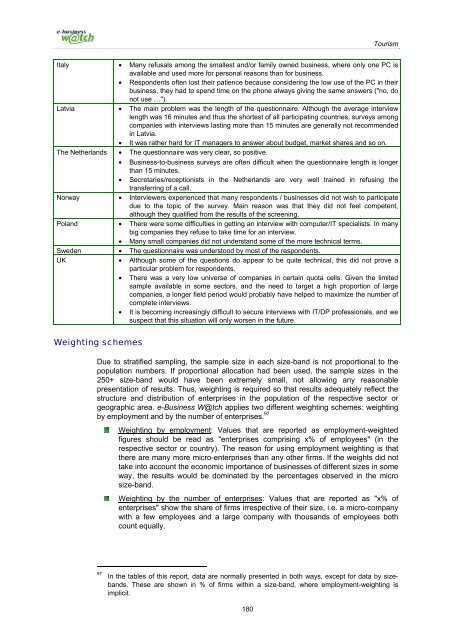ICT and e-business in the tourism industry ICT adoption ... - empirica
ICT and e-business in the tourism industry ICT adoption ... - empirica
ICT and e-business in the tourism industry ICT adoption ... - empirica
Create successful ePaper yourself
Turn your PDF publications into a flip-book with our unique Google optimized e-Paper software.
Tourism<br />
Italy<br />
• Many refusals among <strong>the</strong> smallest <strong>and</strong>/or family owned <strong>bus<strong>in</strong>ess</strong>, where only one PC is<br />
available <strong>and</strong> used more for personal reasons than for <strong>bus<strong>in</strong>ess</strong>.<br />
• Respondents often lost <strong>the</strong>ir patience because consider<strong>in</strong>g <strong>the</strong> low use of <strong>the</strong> PC <strong>in</strong> <strong>the</strong>ir<br />
<strong>bus<strong>in</strong>ess</strong>, <strong>the</strong>y had to spend time on <strong>the</strong> phone always giv<strong>in</strong>g <strong>the</strong> same answers ("no, do<br />
not use …").<br />
Latvia<br />
• The ma<strong>in</strong> problem was <strong>the</strong> length of <strong>the</strong> questionnaire. Although <strong>the</strong> average <strong>in</strong>terview<br />
length was 16 m<strong>in</strong>utes <strong>and</strong> thus <strong>the</strong> shortest of all participat<strong>in</strong>g countries, surveys among<br />
companies with <strong>in</strong>terviews last<strong>in</strong>g more than 15 m<strong>in</strong>utes are generally not recommended<br />
<strong>in</strong> Latvia.<br />
• It was ra<strong>the</strong>r hard for IT managers to answer about budget, market shares <strong>and</strong> so on.<br />
The Ne<strong>the</strong>rl<strong>and</strong>s • The questionnaire was very clear, so positive.<br />
• Bus<strong>in</strong>ess-to-<strong>bus<strong>in</strong>ess</strong> surveys are often difficult when <strong>the</strong> questionnaire length is longer<br />
than 15 m<strong>in</strong>utes.<br />
• Secretaries/receptionists <strong>in</strong> <strong>the</strong> Ne<strong>the</strong>rl<strong>and</strong>s are very well tra<strong>in</strong>ed <strong>in</strong> refus<strong>in</strong>g <strong>the</strong><br />
transferr<strong>in</strong>g of a call.<br />
Norway<br />
• Interviewers experienced that many respondents / <strong>bus<strong>in</strong>ess</strong>es did not wish to participate<br />
due to <strong>the</strong> topic of <strong>the</strong> survey. Ma<strong>in</strong> reason was that <strong>the</strong>y did not feel competent,<br />
although <strong>the</strong>y qualified from <strong>the</strong> results of <strong>the</strong> screen<strong>in</strong>g.<br />
Pol<strong>and</strong><br />
• There were some difficulties <strong>in</strong> gett<strong>in</strong>g an <strong>in</strong>terview with computer/IT specialists. In many<br />
big companies <strong>the</strong>y refuse to take time for an <strong>in</strong>terview.<br />
• Many small companies did not underst<strong>and</strong> some of <strong>the</strong> more technical terms.<br />
Sweden • The questionnaire was understood by most of <strong>the</strong> respondents.<br />
UK<br />
• Although some of <strong>the</strong> questions do appear to be quite technical, this did not prove a<br />
particular problem for respondents.<br />
• There was a very low universe of companies <strong>in</strong> certa<strong>in</strong> quota cells. Given <strong>the</strong> limited<br />
sample available <strong>in</strong> some sectors, <strong>and</strong> <strong>the</strong> need to target a high proportion of large<br />
companies, a longer field period would probably have helped to maximize <strong>the</strong> number of<br />
complete <strong>in</strong>terviews.<br />
• It is becom<strong>in</strong>g <strong>in</strong>creas<strong>in</strong>gly difficult to secure <strong>in</strong>terviews with IT/DP professionals, <strong>and</strong> we<br />
suspect that this situation will only worsen <strong>in</strong> <strong>the</strong> future.<br />
Weight<strong>in</strong>g schemes<br />
Due to stratified sampl<strong>in</strong>g, <strong>the</strong> sample size <strong>in</strong> each size-b<strong>and</strong> is not proportional to <strong>the</strong><br />
population numbers. If proportional allocation had been used, <strong>the</strong> sample sizes <strong>in</strong> <strong>the</strong><br />
250+ size-b<strong>and</strong> would have been extremely small, not allow<strong>in</strong>g any reasonable<br />
presentation of results. Thus, weight<strong>in</strong>g is required so that results adequately reflect <strong>the</strong><br />
structure <strong>and</strong> distribution of enterprises <strong>in</strong> <strong>the</strong> population of <strong>the</strong> respective sector or<br />
geographic area. e-Bus<strong>in</strong>ess W@tch applies two different weight<strong>in</strong>g schemes: weight<strong>in</strong>g<br />
by employment <strong>and</strong> by <strong>the</strong> number of enterprises. 97<br />
Weight<strong>in</strong>g by employment: Values that are reported as employment-weighted<br />
figures should be read as "enterprises compris<strong>in</strong>g x% of employees" (<strong>in</strong> <strong>the</strong><br />
respective sector or country). The reason for us<strong>in</strong>g employment weight<strong>in</strong>g is that<br />
<strong>the</strong>re are many more micro-enterprises than any o<strong>the</strong>r firms. If <strong>the</strong> weights did not<br />
take <strong>in</strong>to account <strong>the</strong> economic importance of <strong>bus<strong>in</strong>ess</strong>es of different sizes <strong>in</strong> some<br />
way, <strong>the</strong> results would be dom<strong>in</strong>ated by <strong>the</strong> percentages observed <strong>in</strong> <strong>the</strong> micro<br />
size-b<strong>and</strong>.<br />
Weight<strong>in</strong>g by <strong>the</strong> number of enterprises: Values that are reported as "x% of<br />
enterprises" show <strong>the</strong> share of firms irrespective of <strong>the</strong>ir size, i.e. a micro-company<br />
with a few employees <strong>and</strong> a large company with thous<strong>and</strong>s of employees both<br />
count equally.<br />
97<br />
In <strong>the</strong> tables of this report, data are normally presented <strong>in</strong> both ways, except for data by sizeb<strong>and</strong>s.<br />
These are shown <strong>in</strong> % of firms with<strong>in</strong> a size-b<strong>and</strong>, where employment-weight<strong>in</strong>g is<br />
implicit.<br />
180

















